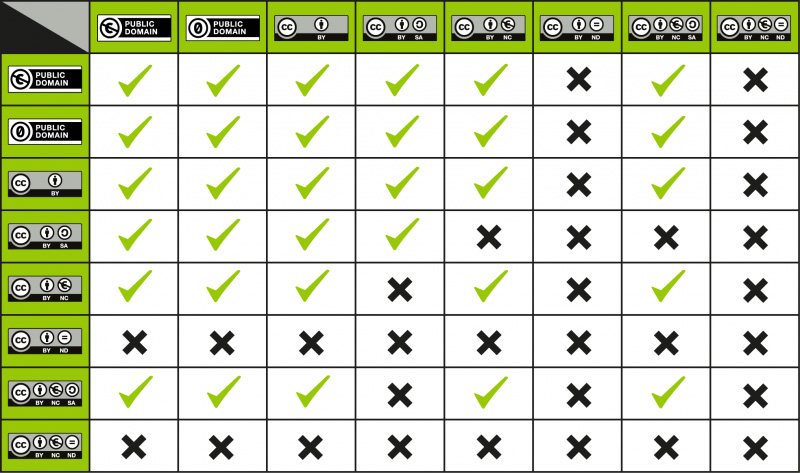2
You can’t beat the creative and editorial control that comes with self-production and open publishing. — Ralph Morelli, Professor of Computer Science, Emeritus, Trinity College. Author of Java, Java, Java: Object-Oriented Problem Solving (CC BY).
Conceptually, open educational resources are not new. Education is about sharing, and many of us have shared lessons, worksheets, and activities with colleagues. Yet it is a paradigm shift to think about using predominantly openly licensed materials, especially textbooks, because most teachers and faculty use a purchased or supplied textbook.
What does it mean to use, adapt and create an openly licensed resource?
Copyright
Copyright. In this day and age where technologies abound and are often tied to large amounts of money, we hear the term a lot. We are used to seeing the little © logo everywhere.
- Copyright is a legal protection that grants someone, often the creator, exclusive rights to use and distribute works. A copyright is a way to protect ‘original works of authorship’ that are in some way tangible, be them published or unpublished. Think of literature, music, and motion pictures.
- Copyright is different from patents, which are for a physical invention, discovery or original method of accomplishing something. Copyright is also different from trademarks, which are nearly always related to visuals, logos, slogans or a combination.
- Copyright protects works and limits sharing. Works with copyright typically are ‘all rights reserved’.
Copyright laws vary from country to country. Further reading on copyright in the U.S.: http://copyright.lib.harvard.edu
Creative Commons
The most common way to share materials as OER is by applying a Creative Commons (CC) license. The CC licenses are standardized, free to use open copyright licenses, and have been adopted by millions of people around the world. You can add a Creative Commons license (creativecommons.org) to your work without any fees, paperwork, or registration.
You’ve also probably seen Creative Common licenses on some materials; there are over 1.2 billion of them online. So, how do copyright and Creative Commons work together?
- Creative Commons licenses work in parallel with copyright, not separately. An author can retain copyright and license their work with a Creative Commons license.
- A Creative Commons license is a way to assign rights about how works can be shared and modified by the public. This can be thought of as ‘some rights reserved.’
- Works that have no ownership, or that the creator has instead chosen to make completely open, become part of the public domain. They have ‘no rights reserved’ (CC0).

Creative Commons Licenses Explained
The following information about Creative Commons license types is from https://creativecommons.org/licenses
Attribution: CC BY
This license lets others distribute, remix, tweak, and build upon your work, even commercially, as long as they credit you for the original creation. This is the most accommodating of licenses offered. Recommended for maximum dissemination and use of licensed materials.
Attribution-ShareAlike: CC BY SA
This license lets others remix, tweak, and build upon your work even for commercial purposes, as long as they credit you and license their new creations under the identical terms. This license is often compared to “copyleft” free and open source software licenses. All new works based on yours will carry the same license, so any derivatives will also allow commercial use.
Attribution-NonCommercial: CC BY NC
This license lets others remix, tweak, and build upon your work non-commercially, and although their new works must also acknowledge you and be non-commercial, they don’t have to license their derivative works on the same terms.
Attribution-NonCommercial-ShareAlike: CC BY NC SA
This license lets others remix, tweak, and build upon your work non-commercially, as long as they credit you and license their new creations under the identical terms.
Attribution-NoDerivatives: CC BY ND
This license allows for redistribution, commercial and non-commercial, as long as it is passed along unchanged and in whole, with credit to you. This ND license is not OER complaint… because it does not allow works to be revised or remixed.
Attribution-NonCommercial-NoDerivs: CC BY NC ND
This license is the most restrictive of our six main licenses, only allowing others to download your works and share them with others as long as they credit you, but they can’t change them in any way or use them commercially. This ND license is not OER complaint… because it does not allow works to be revised or remixed.
Unsure of which license to choose? https://creativecommons.org/choose/
Mixing and Matching
A great benefit to using Creative Commons materials is the ability to mix and match or “remix”. Authors don’t have to constantly create their works from scratch. Instead, they can revise or remix existing content. Most CC licenses allow for reuse without issue, but some licenses can be tricky if you want to modify the work.
The table below summarizes which CC licensed content can be remixed with other CC licensed content. Note: When remixing materials with different CC licenses, ensure the licenses do not conflict before proceeding. If licenses do conflict, determine which materials have a conflicting license and try to find alternatives; or create new content; or create a “collection” – by placing various CC licensed works next to each other without remixing them. Be sure to properly attribute each work in a remix or in a collection.

Attribution
All Creative Commons licenses require attribution. See the Creative Commons wiki on best practices for attribution.
Molly Kleinman, former copyright specialist for the University of Michigan Library, offers further explanation on how to attribute a Creative Commons licensed work.
Disclaimer: We are not lawyers. This is in no way legal advice. In your path to create an open resource, you may want to consult with legal or copyright specialists.
![]() For more, see Self-Publishing Guide, Copyright and Open Licenses [New Tab].
For more, see Self-Publishing Guide, Copyright and Open Licenses [New Tab].
